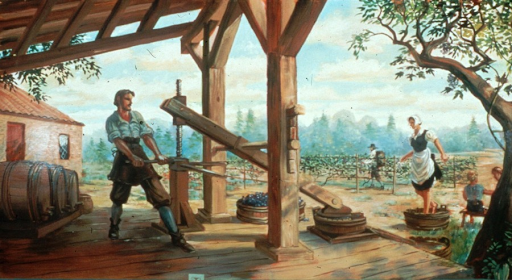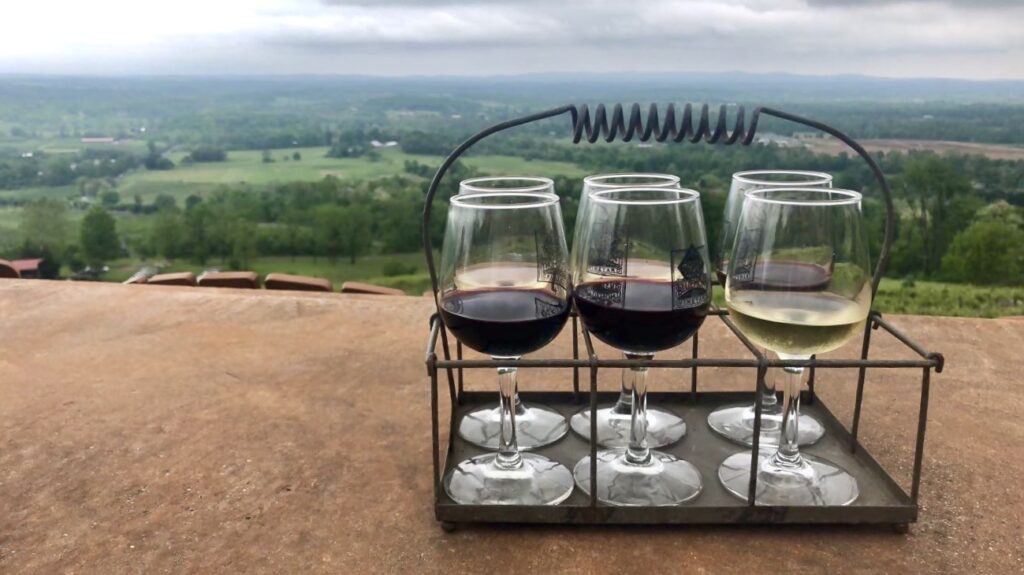To understand wine is to understand history. We make wine from grapes off mature vines that have soaked up the environmental record from the ground. We drink wine from grapes harvested in the past, sometimes decades ago.
Generation to generation, we passed down the wisdom of the vine through the centuries. It is one of mankind’s longest enduring gifts to the future. The wineries of Virginia continue this reverence for the past while propelling the vine into the future.
In ancient times, Romans carried wine while crossing the European continent, leaving behind a rich tradition of viticulture and an appreciation for the grape; the politics of conquerors notwithstanding. Throughout the old world, wine was ubiquitous in nearly every country and community. Consequently, wine accompanied nearly every traveler and explorer seeking to find new routes and new opportunities.

Early Settlers and Virginia Wine
Many think of Napa Valley and California when they think of wine in America. But in reality, Virginia is the birthplace of American wine. Nowhere in history has hope and opportunity been more synonymous than the New World. Early settlers brought that spirit to Virginia in 1607. In 1619, the House of Burgesses, the ruling body in Virginia at the time, declared in Acte 12 that vineyards must be planted. In the modern era, it is difficult to imagine a single crop being so important as to be mandated by legal decree!
In the latter part of the 18th Century, as America was boiling to the point of revolution, so too was the wine in Virginia. Washington, James Monroe, and Thomas Jefferson, a dedicated oenophile, helped create the Virginia Wine Company consisting of over 2,000 acres dedicated to making wine outside of Charlottesville. A century later, in 1873, a wine-growing cooperative named Monticello Wine Company, continued the wine-growing tradition in Virginia establishing the region as internationally recognized and viticulturally important. Winemaking in Virginia continued unabated until Prohibition ended the harvest in 1916.
Virginia First to Harvest Wine
Fast forward through those dark times to the 1970’s. Thanks to California, America was once again learning the secrets of the grape, to much acclaim. Virginia, the first to harvest the vine in America, was not to be outgrown. New vineyards and wineries began to emerge and by 2005, there were over 100 vineyards in Virginia.
Virginia Wine Popularity Today
The number of wineries in Virginia has increased dramatically. Today, there are nearly 300 wineries and vineyards throughout the state partitioned through recognized vinicultural regions. Due to its mild climate and unique landscape, Virginia grows numerous grapes extremely well, resulting in outstanding and award-winning varietals.
Cabernet Sauvignon, Viognier, Cabernet Franc, and Chardonnay are amongst the most popular, but other varietals can be found easily. More obscure grapes like the Viognier, Petit Verdot, Nebbiolo, and Riesling have found substantial popularity as well.

Early Virginia winemakers did so as part of subsistence farming, but today’s vineyards yield serious crops and the wineries are a substantial tourist draw in Virginia. Although there are several large-scale wine production companies in the state, many rely on visitors and direct-to-consumer purchases. There has been no better time in history to explore Virginia’s wine regions.
While popular culture has recently noted that the Virginia wine revolution has begun, in truth, wine has been in Virginia for over 400 years. We in the modern era are just starting to catch up to that history.
Sources:
https://www.abc.virginia.gov/products/product-knowledge/buying-guide-wine

